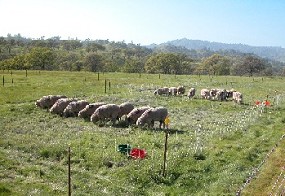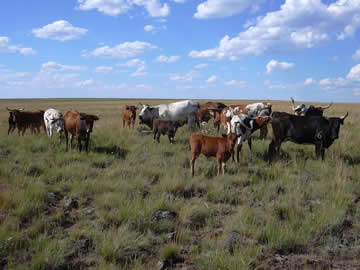Grazing And Medusahead Chemistry
 Medusahead Palatability
Medusahead Palatability
LUSK, W. C., M. B. JONES, P. J. TORELL, and C. M. McKELL. 1961. J. Range Manage. 14:248-251.
Location: Ukiah, California.
A grazing test was conducted with sheep to investigate the palatability of medusahead on fertilized and unfertilized annual range. The results indicated that: (1) sheep, given a free choice, did eat medusahead as long as it was green, (2) sheep held in a small plot area ate some medusahead even when it had headed out and dried, (3) heavy grazing in the spring resulted in a
thinned stand of medusahead at maturity as compared to a dense stand of medusahead resulting from light or no grazing, and (4) consumption with forced grazing showed that fertilized medusahead was grazed more than unfertilized medusahead since a greater amount of medusahead was taken from the fertilized plots early in the season. This resulted in less medusahead on the grazed-fertilized areas late in the season as compared to grazed unfertilized areas. However, palatability measured by esophageal fistula technique suggested there was no difference between the percentage of medusahead in the diet from fertilized and unfertilized areas.
Utilization and Palatability of Medusahead by Sheep as Affected by Growth Stage and Soil Fertility
LUSK, W. C., M. B. JONES, P. J. TORELL, and C. M. McKELL. 1960. Proc. Calif. Sec. Soc. Range Manage. Fresno, California. p. 41-45. (Mimeo release.)
Location: California
Sheep appeared to prefer fertilized strips of medusahead, and it was apparent that heavy grazing was damaging the plant. Measurements indicated that 25 percent of vegetation in the fertilized strip was medusahead, compared to 65 percent medusahead in the unfertilized strip. Results of this study showed medusahead may be eaten by sheep during most of its growth stages, particularly before the formation of seedheads.
The Medusahead Problem
HIRONAKA, M. 1965. IN: Proceedings of the Cheatgrass Symposium, Vale, Oregon. (Portland) Bureau of Land Management. p. 62-65.
In the sagebrush grass region, medusahead represents the highest annual grass stage in secondary succession. Medusahead is better able to make fuller utilization of site resources than cheatgrass. Replacement of cheatgrass is apparent because of the higher reproductive success of medusahead. Cattle will graze medusahead more freely where the old growth of medusahead is absent. With heavy use, old growth does not accumulate and greater use of medusahead can be obtained during the pre-head stage.
 Medusahead Invasion as Influenced by Herbicides and Grazing on Low Sagebrush Sites
Medusahead Invasion as Influenced by Herbicides and Grazing on Low Sagebrush Sites
James Young and Raymond Evans. 1971. Journal of Range Management 24:451-454
Spraying 2,4-D for brush control combined with application of atrazine for herbaceous weed control further increased perennial grasses when not grazed, but with grazing, medusahead greatly increased at the expense of perennial grasses 3 years after treatment.
Applications of 1 lb/acre of atrazine eliminated all annual vegetation the year following application. On heavily grazed plots treated with 2,4-D and atrazine, there was severe injury to the native perennial grasses followed by an increase of medusahead.
In contrast, on non-grazed plots, the atrazine treatment increased perennial grasses, with only an occasional medusahead plant present.
This study confirms that a stable perennial grass/low sagebrush community is an effective barrier against medusahead invasion.
Selectivity of Range Grass Seeds by Local Birds
Goebel, C.J., and C. Berry. 1976. J. Range Manage. 29:393-395.
Location: Pacific Northwest
In several studies, seeds of six perennial grasses were broadcast over an area. Twenty-five species of birds were observed in 1969. Seeds least preferred were those of the annuals cheatgrass and medusahead. Resowings under litter cover were successfully hidden from most birds until germination. Medusahead may increase competitive advantage by seeds not preferred by birds as well as hiding under the thatch layer.
Utilization of Medusahead and Downy Brome Caryopses by Chukar Partridges
David E. Savage, James A. Young and Raymond A. Evans. 1969. J. Wildlife Manage. 33:4, pp. 975-978.
Location: Reno, Nevada
Objective: To determine if chucker partridges would ingest medusahead and if injuries would result from the ingestion.
Methods: 30 chucker partridges were divided into 3 groups of 10 and fed either unlimited amounts of commercial game bird pellets, downy brome or medusahead caryopses. After the first week of trials, the downy brome and medusahead groups were also supplemented with game bird pellets in order to keep birds alive.
Results: Downy brome and medusahead had similar chemical composistions. Birds began eating foods immediately when first given, but showed some selective foraging behavior for both downy brome and medusahead. After 3 days, unusual behavior (i.e. picking) was observed in the medusahead group, and became even more evident after 6 days. Birds in both the medusahead and downy brome groups lost weight during the first week, and were thus supplemented with pellets for the rest of the trial. The downy brome birds improved with supplementation, but the medusahead birds continued to show extreme signs of weakness (inability to fly or run when approached) and picking after 10 days. The study was stopped at this point to avoid killing the medusahead birds.
Largely undamaged medusahead caryopses were found in the droppings of birds, which suggested that the digestibility of medusahead by chukar partridge was quite low. On the other hand downy brome caryopses appeared to be completely digested, although weight gains were low for this group as well. Thus, chucker partridge appeared to eat medusahead but showed obvious signs of nutritional deficiency, suggesting that medusahead is not a suitable forage for these birds.
Silica in Medusahead
Charles F. Swenson, Duane Le Tourneau and Lambert C. Erickson. 1964. Weeds 12:1, pp. 16-18.
Location: Nez Perce County and Washington County, Idaho
Methods: Plant samples (from seedling to maturity) were collected at weekly intervals from April 13 to July 7, 1960 in northern and southern Idaho. The ash and silica content of medusahead samples were determined using the methods of C.S. Piper (1947). A petrographic microscope (Leitz, DIALUX-POL) was used for determining the areas of deposition and the mineral form of silica. A General Electric model XRD-5 X-ray diffractometer with a copper target X-ray tube was used in the X-ray diffraction studies.
Results: The ash and silica content (dry weight basis) decreased as the plant matured (13.9 to 9.6 in Nez Perez Co & 10.7 to 9.8 in Washington Co). The total ash of the entire plant contained from 72-89 per cent silica, regardless of growth stage. Similar percentages of silica in ash were obtained in the culms, heads, and seeds of the plant. X-ray diffraction patterns and polarizing microscope examinations showed the mineral form of silica to be opal. Heavy deposition of silica was found in the barbs of awns, in the epidermis of the leaves, culms, glumes and seeds, and in strands beneath the epidermis.
The Chemical Composition of Medusahead and Downy Brome
Bovey, R.W., D. Le Tourneau and L.C. Erickson. 1961. Weeds 9(2):307-311.
Location: Nez Pierce, Idaho
Chemical analysis: Medusahead and downy brome were harvested at five different sampling dates and stages of development from May to July. Samples were analyzed according to standard methods. The moisture, crude protein, crude fat, crude fiber, and lignin contents of medusahead were comparable to that of downy brome and many desirable grass species. The ash content of medusahead, however, was found to be much greater than that of downy brome and of many other grasses. The ash of medusahead contained silica amounting to over 10% of the dry weight of the plant.
Grazing trial: Fertilization at 160 lb N resulted in 90% consumption of medusahead by free ranging horses and cattle grazing together. Fertilization at 20 lb N resulted in only 40% consumption. The cost of fertilization is prohibitive and medusahead plants were still able to produce seed. No details were given on timing of fertilization on grazing.
Silage trial: Medusahead silage was prepared without additives, with molasses, with beet pulp, and both molasses and beet pulp. All samples were rejected by 40 hungry sheep accustomed to silage.
30 Years Of Medusahead: Return To Fly Blown-Flat: Researchers revisit a site once free of the invasive grass medusahead to see what lessons can be learned
Joseph Wagner, Richard Delmas, and James A. Young. 2001. Rangelands 23:6-9.
- An experimental study site was established to study the invasive exotic grass medusahead. A fenced exclosure to exclude cattle was established in 1967.
- The site was originally chosen because medusahead had not yet invaded the site, but based on the soils and plant community present on the site and the immediate adjacent infestation of medusahead, it appeared the site would soon be invaded. The site represented the millions of acres on the margin of the Great Basin that appeared susceptible to medusahead invasion.
- After 30 years, the short-lived native perennial grass greatly increased in abundance on plots within the exclosure, but this increase did not dampen the frequency of medusahead.
- Thirty years of protection from grazing did not prevent medusahead invasion and prolonged persistence of the weed. It is also apparent that except for specific soils (deep churning clays) of limited extent, grazing did not lead to the total dominance of medusahead.

